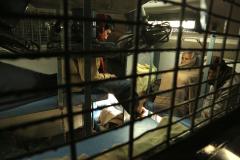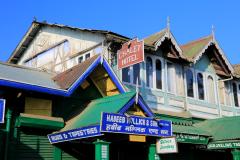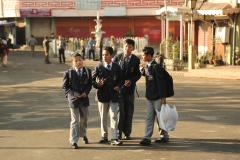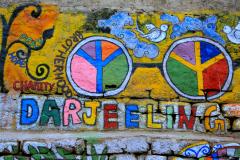Darjeeling - steps away from Himalayas
Fresh air, clean streets and tea in yet another Queen of the Hill Stations
I fell in love. With Zen Buddhism monk Milo Finn. I had a chance to attend only 3 of them, but I loved his evening Zen teachings. It almost broke my heart to leave Bodhgaya.
This is a new record: 572km in 28 hours, without any longer layover. Going by bike would be faster! Well, no, because I moved from Bodhgaya, which is down on the plains, to Darjeeling, which is more than 2100 meters above sea level. But 90% of that ascent was done in last 2,5 hours, so still the speed of this transfer is ill! So, it took 1 hour on rickshaw from Bodhgaya to Gaya, which is 13km! Then I waited for about 1 hour in Gaya for train to Patna (and I was pretty lucky that there still was any train, because I arrived quite late), 3 hours in train from Gaya to Patna (110km), 2 hours layover in Patna, and then 14 hours in train from Patna to New Jalpaiguri (500km) – I finally experienced sleeping in Indian night train – 1 hour from New Jalpaiguri to Siliguri (kick-off town for Darjeeling), 1 hour waiting for a taxi-jeep to fill up (12 people), and finally last 2,5 hours (65 km) on serpentines to Darjeeling. But apart from taking it so fucking long, it was actually quite smooth transfer and I even managed to get some minimal reasonable amount of sleep on the train, so no complaints.
I’m in Darjeeling – world famous tea superpower. And another “Queen of the Hill Stations”. I told you that every hill station considers itself the gueen of them all, but Darjeeling probably really is the Queen.
Darjeeling is, if not the most lovable, then surely among India's 3 most lovable places on my journey (together with Varkala and Rameshwaram). Air is clean. Streets are clean. People are super friendly (and speak English). Tibetan goods and clothes on sale are probably the most beautiful things I've ever seen (not that I'm going to buy anything). Tea, well, you know how is the tea. Street food abounds and is cheap. And somewhere behind that thick fog are Himalayas (I hope to see them soon). Darjeeling, you are my darling!
The only problem is that it’s so freaking cold here! I mean the cold would be bearable, it’s like early spring in Slovakia (14’C during, around 2’C at night), if only my guesthouse had any heating. Or at least hot water. So once again I sleep in winter clothes and gloves. And as for the shower, it turned out to be a good idea that I practices showering in cold water and bathing in Ganga – remember I had hot shower only in Varanasi. Because now I had to take a “shower” in a bathroom chilled to maybe 9’C with water of the same temperature. And it’s not actually shower. I haven’t seen any shower since I left Varanasi, it’s always cold water in bucket all the time. So, the worst part it that instead of taking 30 second shower in freezing water, I had to spill small buckets of the freezing water over me. And that means that you have to actively torture yourself and it takes few minutes to get wash yourself :-) Few days later I purchased a bucket of hot water from the guesthouse owner, so I enjoyed few minutes of warmth. Because there is almost nowhere you can warm up in this town. Heating is non-existent not only in guesthouses (I mean my price category) but also in restaurants. So drinking tea is about the only option for heating yourself. The locals walk around the town in flip flops bare feet and in shorts – obviously I’m hopelessly sissy.
But actually, the cold and fresh air did their magic and finally I feel OK and healthy. I’m bit short of breath, that is probably caused by the altitude and the fact there are few straight streets in Darjeeling, basically you go up and down all the time, as Darjeeling is situated on top of steep cliff-like hill. I’d better get in form fast, if I want to go to trek in Nepal.
Darjeeling has a slight touch of Europe – many guesthouses and lodges look like mountain lodges in Alps, kids wear ridiculously formal school uniforms and women in saris were replaced by women wearing relatively western fashion. Obviously, impact of British was/is huge here.
Also ethnic composition of the population is completely different from the rest of India. There are few “true Indians”. Overwhelming majority of the population is related to Nepali and Tibetans . The closeness of Tibet is obvious not just in souvenir shops and by ethnicity of the people: Buddhism dominates or at least equals Hinduism here. And no rickshaws! They can’t climb the steep road to Darjeeling which is, using Indian terminology “jeepable”. All in all, Darjeeling looks nothing like the rest of India. Maybe that’s what makes it so lovable :-)



